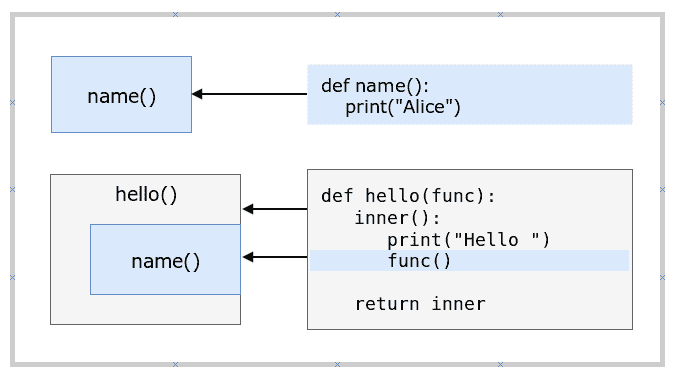在本教程中学习 Python 装饰器。
使用装饰器向现有函数添加功能。 这称为元编程。
一个函数可以将一个函数作为参数(要修饰的函数),并返回带或不带扩展名的相同函数。
扩展函数有时非常有用,我们将在本文稍后展示真实的示例。
函数是对象
在 Python 中,一切都是对象,包括函数。 这意味着函数可以传递并返回。 当您看到它时,乍一看可能很奇怪:
def hello():print("Hello")# even functions are objectsmessage = hello# call new functionmessage()
调用message()或hello()方法,它们具有相同的输出。 那是因为他们指的是同一个对象。
现在让我们继续装饰。
装饰器
示例
装饰器接受一个函数,对其进行扩展并返回。 是的,函数可以返回函数。
def hello(func):def inner():print("Hello ")func()return innerdef name():print("Alice")obj = hello(name)obj()
在上面的示例中,hello()是装饰器。
在
语句中
obj = hello(name)
函数name()由函数hello()装饰。
它将函数包装在另一个函数中。

示例 2
可以通过包装函数来扩展它们。
def who():print("Alice")def display(func):def inner():print("The current user is : ", end="")func()return innerif __name__ == "__main__":myobj = display(who)myobj()
who()函数由display()装饰。
语法糖
装饰器是常见的,可以简化。 尽管功能完全相同,但代码更简洁。
Python 可以使用@符号简化装饰器的使用。
@hellodef name():print("Alice")if __name__ == "__main__":name()
这将输出完全相同的内容,但是是编写代码的更简洁的方法。
跟我在一起。调用:
@hellodef name():
只是一种更简单的书写方式:
obj = hello(name)
在这两种情况下,我们都将装饰器应用于函数。
参数
参数可以与装饰器一起使用。 如果您有一个打印总和a + b的函数,例如
def sumab(a,b):summed = a + bprint(summed)
您可以将其包装在装饰器函数中。以下示例显示了如何执行此操作:
def pretty_sumab(func):def inner(a,b):print(str(a) + " + " + str(b) + " is ", end="")return func(a,b)return inner@pretty_sumabdef sumab(a,b):summed = a + bprint(summed)if __name__ == "__main__":sumab(5,3)
函数sumab由函数pretty_sumab包装。 这用其上方的@符号表示。
调用函数sumab,并查看带有参数的函数sumab和pretty_sumab的逻辑都已运行。
真实示例
用例:时间测量

装饰器可用于测量函数执行所需的时间。
如果您定义了一个休眠的简单函数,则
def myFunction(n):time.sleep(n)
然后,您只需添加@measure_time行即可测量所需的时间
下面的例子:
import timedef measure_time(func):def wrapper(*arg):t = time.time()res = func(*arg)print("Function took " + str(time.time()-t) + " seconds to run")return resreturn wrapper@measure_timedef myFunction(n):time.sleep(n)if __name__ == "__main__":myFunction(2)
这将输出执行函数myFunction()所花费的时间。 很酷的事情是,通过添加一行代码@measure_time,我们现在可以测量程序执行时间。

用例:Web 应用程序
让我们以 Web 应用程序的使用案例为例。 在 Flask 中构建 Web 应用程序时,您始终会编写网址路由。
每个路由都是 Web 应用程序中的特定页面。打开页面/about可以调用about_page()方法。
@app.route("/about")def about_page():return "Website about nachos"
在这种情况下,它使用@符号进行装饰。

